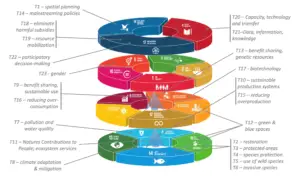
Why in news?
- The Kunming-Montreal Global Biodiversity Framework (GBF) represents a significant global initiative designed to address the dual challenges of promoting sustainable development and conserving biodiversity.
- Envisioned during the 15th meeting of the Conference of the Parties to the UN Convention on Biological Diversity, this framework sets forth ambitious goals and targets aimed at fostering biodiversity preservation on a worldwide scale.
- However, amidst its overarching aims, recent discourse has arisen concerning the potential repercussions of the Global Biodiversity Framework, particularly concerning India’s indigenous tribes.
- These communities have historically depended on natural resources for their livelihoods, and any alterations to their access or utilization of these resources could profoundly impact their way of life.
- As such, there are growing concerns about the potential unintended consequences that the implementation of the GBF may have on these vulnerable populations.
Understanding the Kunming-Montreal Global Biodiversity Framework:
- The Global Biodiversity Framework, adopted during the 15th meeting of the Conference of the Parties to the UN Convention on Biological Diversity, sets ambitious goals and targets for biodiversity conservation by 2030 and 2050.
- One of its key targets is to increase protected areas to at least 30% of the world’s terrestrial area by 2030.
- While India has made progress in expanding protected areas, concerns arise over the potential impact on indigenous tribes.
Implications for India’s Indigenous Tribes:
- The expansion of protected areas under the Global Biodiversity Framework could restrict traditional land use practices and livelihoods of indigenous communities, leading to increased poverty and food insecurity.
- Many of India’s national parks and wildlife sanctuaries are located in areas inhabited by indigenous peoples, putting their existence at risk. For example, initiatives to upgrade wildlife sanctuaries to tiger reserves or expand existing protected areas could displace tribal villages.
Utilizing Indigenous Knowledge in Biodiversity Conservation:
- India can leverage the knowledge and practices of indigenous tribes in biodiversity conservation efforts.
- Initiatives such as supporting ecotourism projects led by indigenous communities not only preserve cultural heritage but also generate income and foster wildlife conservation.
- Integrating traditional knowledge with scientific surveys can lead to comprehensive conservation plans, as seen in the protection of sacred groves by tribes like the Khasi and Jaintia.
Promoting Co-Management Models:
- Co-management models, such as the Joint Forest Management program in West Bengal, where indigenous communities work alongside forest departments, can foster a sense of ownership and leverage indigenous knowledge for sustainable resource management.
- These models grant indigenous communities a stake in wildlife management and incentivize conservation practices.
Ensuring Indigenous Rights and Conservation:
- It is imperative for the Indian government to uphold the principles of Free, Prior, and Informed Consent (FPIC) before establishing protected areas on tribal lands.
- Conducting social impact assessments can help understand the potential ramifications of protected area expansion on existing livelihoods.
- Aligning national policies with international standards, such as the United Nations Declaration on the Rights of Indigenous Peoples (UNDRIP), is essential to ensure that indigenous rights and knowledge systems are respected in conservation efforts.
Conclusion:
- Balancing biodiversity conservation with the rights and livelihoods of indigenous tribes is crucial for sustainable development in India.
- By integrating indigenous knowledge, promoting co-management models, and upholding indigenous rights, India can effectively navigate the implications of the Kunming-Montreal GBF while ensuring the preservation of its rich biodiversity and cultural heritage.
People also ask
1. What is the Kunming-Montreal Global Biodiversity Framework (GBF)?
Ans: The Global Biodiversity Framework is a comprehensive initiative adopted during the 15th meeting of the Conference of the Parties to the UN Convention on Biological Diversity. It sets ambitious goals for biodiversity conservation globally.
2. How does the GBF impact India’s indigenous tribes?
Ans: The expansion of protected areas under the Global Biodiversity Framework could potentially restrict traditional land use practices and livelihoods of indigenous communities, leading to increased poverty and food insecurity.
3. What progress has India made towards GBF targets?
Ans: India has made strides in expanding protected areas, but concerns remain regarding legal definitions and diversions of these areas for non-conservation purposes.
Can you be more specific about the content of your article? After reading it, I still have some doubts. Hope you can help me.
Your point of view caught my eye and was very interesting. Thanks. I have a question for you.